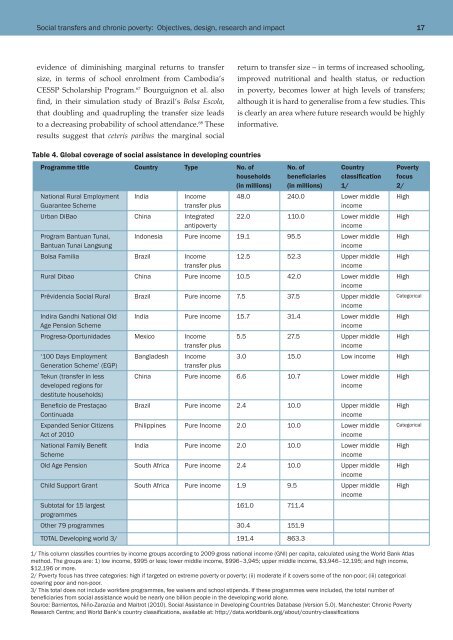Social transfers and chronic poverty
You also want an ePaper? Increase the reach of your titles
YUMPU automatically turns print PDFs into web optimized ePapers that Google loves.
<strong>Social</strong> <strong>transfers</strong> <strong>and</strong> <strong>chronic</strong> <strong>poverty</strong>: Objectives, design, research <strong>and</strong> impact<br />
17<br />
evidence of diminishing marginal returns to transfer<br />
size, in terms of school enrolment from Cambodia’s<br />
CESSP Scholarship Program. 67 Bourguignon et al. also<br />
find, in their simulation study of Brazil’s Bolsa Escola,<br />
that doubling <strong>and</strong> quadrupling the transfer size leads<br />
to a decreasing probability of school attendance. 68 These<br />
results suggest that ceteris paribus the marginal social<br />
return to transfer size – in terms of increased schooling,<br />
improved nutritional <strong>and</strong> health status, or reduction<br />
in <strong>poverty</strong>, becomes lower at high levels of <strong>transfers</strong>;<br />
although it is hard to generalise from a few studies. This<br />
is clearly an area where future research would be highly<br />
informative.<br />
Table 4. Global coverage of social assistance in developing countries<br />
Programme title Country Type No. of<br />
households<br />
(in millions)<br />
National Rural Employment<br />
Guarantee Scheme<br />
India<br />
Income<br />
transfer plus<br />
Urban DiBao China Integrated<br />
anti<strong>poverty</strong><br />
Program Bantuan Tunai,<br />
Bantuan Tunai Langsung<br />
Bolsa Familia Brazil Income<br />
transfer plus<br />
No. of<br />
beneficiaries<br />
(in millions)<br />
Country<br />
classification<br />
1/<br />
48.0 240.0 Lower middle<br />
income<br />
22.0 110.0 Lower middle<br />
income<br />
Indonesia Pure income 19.1 95.5 Lower middle<br />
income<br />
12.5 52.3 Upper middle<br />
income<br />
Rural Dibao China Pure income 10.5 42.0 Lower middle<br />
income<br />
Prêvidencia <strong>Social</strong> Rural Brazil Pure income 7.5 37.5 Upper middle<br />
income<br />
Indira G<strong>and</strong>hi National Old<br />
Age Pension Scheme<br />
Progresa-Oportunidades Mexico Income<br />
transfer plus<br />
‘100 Days Employment<br />
Generation Scheme’ (EGP)<br />
Tekun (transfer in less<br />
developed regions for<br />
destitute households)<br />
Beneficio de Prestaçao<br />
Continuada<br />
Exp<strong>and</strong>ed Senior Citizens<br />
Act of 2010<br />
National Family Benefit<br />
Scheme<br />
India Pure income 15.7 31.4 Lower middle<br />
income<br />
Bangladesh<br />
Income<br />
transfer plus<br />
5.5 27.5 Upper middle<br />
income<br />
Poverty<br />
focus<br />
2/<br />
High<br />
High<br />
High<br />
High<br />
High<br />
Categorical<br />
High<br />
High<br />
3.0 15.0 Low income High<br />
China Pure income 6.6 10.7 Lower middle<br />
income<br />
Brazil Pure income 2.4 10.0 Upper middle<br />
income<br />
Philippines Pure Income 2.0 10.0 Lower middle<br />
income<br />
India Pure income 2.0 10.0 Lower middle<br />
income<br />
Old Age Pension South Africa Pure income 2.4 10.0 Upper middle<br />
income<br />
Child Support Grant South Africa Pure income 1.9 9.5 Upper middle<br />
income<br />
Subtotal for 15 largest<br />
programmes<br />
161.0 711.4<br />
Other 79 programmes 30.4 151.9<br />
TOTAL Developing world 3/ 191.4 863.3<br />
1/ This column classifies countries by income groups according to 2009 gross national income (GNI) per capita, calculated using the World Bank Atlas<br />
method. The groups are: 1) low income, $995 or less; lower middle income, $996–3,945; upper middle income, $3,946–12,195; <strong>and</strong> high income,<br />
$12,196 or more.<br />
2/ Poverty focus has three categories: high if targeted on extreme <strong>poverty</strong> or <strong>poverty</strong>; (ii) moderate if it covers some of the non-poor; (iii) categorical<br />
covering poor <strong>and</strong> non-poor.<br />
3/ This total does not include workfare programmes, fee waivers <strong>and</strong> school stipends. If these programmes were included, the total number of<br />
beneficiaries from social assistance would be nearly one billion people in the developing world alone.<br />
Source: Barrientos, Niño-Zarazúa <strong>and</strong> Maitrot (2010). <strong>Social</strong> Assistance in Developing Countries Database (Version 5.0). Manchester: Chronic Poverty<br />
Research Centre; <strong>and</strong> World Bank’s country classifications, available at: http://data.worldbank.org/about/country-classifications<br />
High<br />
High<br />
Categorical<br />
High<br />
High<br />
High

















